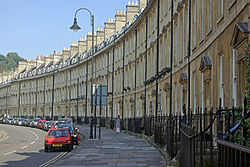| The Paragon | |
|---|---|
 | |
| Location | Bath, Somerset, England |
| Coordinates | 51°23′12″N 2°21′36″W / 51.38667°N 2.36000°W |
| Built | 1768 |
| Architect | Thomas Warr Attwood |
| Architectural style(s) | Georgian |
Listed Building – Grade I | |
| Official name | 1 to 21, Paragon |
| Designated | 12 June 1950[1] |
| Reference no. | 1394239 |
Listed Building – Grade II | |
| Official name | Axford's Buildings |
| Designated | 12 June 1950[2] |
| Reference no. | 1394242 |
Listed Building – Grade II | |
| Official name | Walcot Church House |
| Designated | 11 August 1972[3] |
| Reference no. | 1394243 |
Listed Building – Grade II | |
| Official name | Walcot Cemetery gate and wall |
| Designated | 12 June 1950[4] |
| Reference no. | 1394247 |
The Paragon in the Walcot area of Bath, Somerset, England is a street of Georgian houses which have been designated as listed buildings. It was designed by Thomas Warr Attwood.[5] It now forms part of the A4.
Numbers 1 to 21 are 3 storey houses with mansard roofs. Each building has matching doors and windows with central pediments and flat entablatures either side of the 1st floor windows and Tuscan pilasters and pediments to the doorways.[1]
Numbers 22 to 37 continue the theme from numbers 1 to 21 and were completed in 1775 by Joseph Axford, a local mason. Numbers 28 to 32 were damaged by bombing during World War II but have since been restored.[2]
- ^ a b "Numbers 1 to 21". Images of England. English Heritage. Archived from the original on 18 October 2012. Retrieved 9 August 2009.
- ^ a b "Numbers 22 to 37". Images of England. English Heritage. Archived from the original on 24 October 2012. Retrieved 9 August 2009.
- ^ Cite error: The named reference
churchhousewas invoked but never defined (see the help page). - ^ Cite error: The named reference
cemeterygatewaywas invoked but never defined (see the help page). - ^ Lewis Baker, David. "The Paragon Bath #1". Yessy art gallery. Retrieved 9 August 2009.
